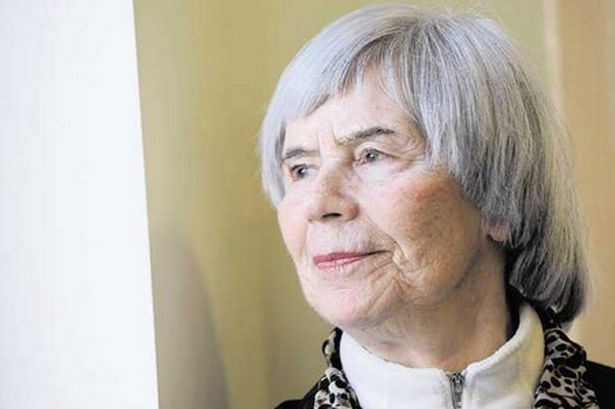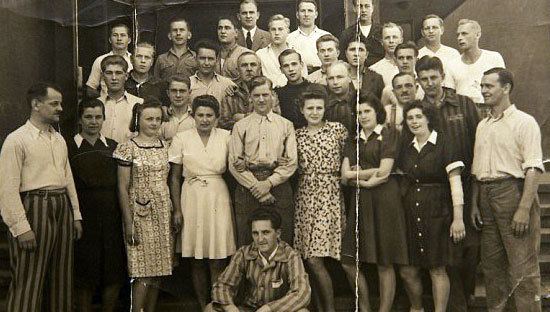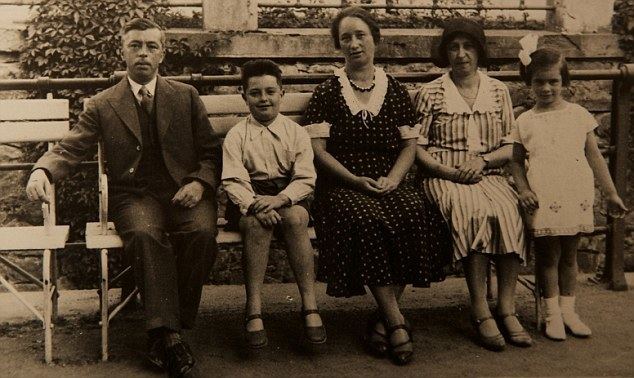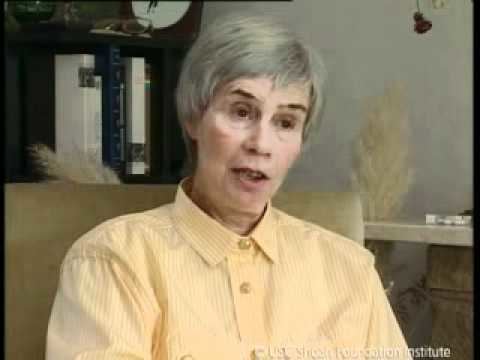Name Kitty Hart-Moxon | ||
 | ||
Jewish survivor kitty hart moxon testimony part 1
Kitty Hart-Moxon, OBE (born December 1, 1926) is a Polish-English Holocaust survivor. She was sent to the Auschwitz-Birkenau death camp in 1943 at age 16, where she survived for two years, and was also imprisoned at other camps. Shortly after her liberation in April 1945 by American soldiers, she moved to England with her mother, where she married and dedicated her life to raising awareness of the Holocaust. She has written two autobiographies entitled I am Alive (1961) and Return to Auschwitz (1981).
Contents
- Jewish survivor kitty hart moxon testimony part 1
- Return to auschwitz with kitty hart moxon yorkshire tv c 1979
- Early life
- Ghettos
- Auschwitz II Birkenau
- The death marches
- Liberation
- After the war
- Honours
- References

Return to auschwitz with kitty hart moxon yorkshire tv c 1979
Early life

Kitty Hart-Moxon was born Kitty Felix, on 1st December 1926, in the southern Polish town of Bielsko (known as Bielitz in German), which bordered both Germany and Czechoslovakia. She was the second child of Karol Felix and his wife Lola Rosa Felix, who had a son five years Kitty's senior, named Robert. Karol Felix (born c. 1888) had studied law in Vienna, and had also been a captain in the Austrian army in the First World War. Upon his father’s death, he took over his agricultural supply business, which he ran with his sister, until the outbreak of the war. Lola’s father was also in the agricultural business: he was a farmer, who owned his own land, and Kitty believes that this may have been how her parents met - with Lola’s father potentially using Karol as a supplier. Kitty’s paternal family had come from Italy hundreds of years ago - it had been said that one of her ancestors had been called to attend to the King of Poland, as he was a doctor, and that is how the family came to reside in Poland. Her mother was born on 18th February 1890, to a Slovakian father and his wife. Lola’s sister had studied medicine in Vienna, and Lola herself went to England in 1911 to study English at Bedford College, London - eventually becoming an English teacher in Poland, where she taught children preparing for their state examinations (this meant it was an advanced level of English learning).

Prior to the end of the First World War, Poland had been partitioned into three parts, with each part belonging to either Austria-Hungary, the German Empire, or the Russian Empire; the town of Bielsko belonged to Austria-Hungary. The majority of Austro-Hungarians’ were German speakers, and due to the fact Bielsko belonged to Austria-Hungary, many of its residents were German speakers, including Kitty’s parents, and as a result of this, the Felix family spoke German at home, with Kitty not learning a word of Polish until she began attending school. Kitty also began learning basic English in nursery, where her mother - who was teaching at the nursery at the time - taught the children English nursery rhymes.

Growing up, Kitty was extremely sporty, and participated in gymnastics, athletics, swimming, and skiing. Meanwhile, both her parents, and her brother, enjoyed ballroom dancing. Her parents also enjoyed socialising: they had a wide circle of Jewish friends, with whom they frequently went out with. The family led quite a prosperous lifestyle: they travelled a lot; employed domestic staff; lived in comfortable accommodation; could afford to send Kitty to private school; and had lavish birthday celebrations - even including parties on ice.

Lola and Karol Felix were liberal Jews: they did not observe Jewish customs, including not keeping a kosher home (in fact, Kitty states that she did not even know what kosher was until after her family had fled to Lublin); and the family only attended synagogue at occasions. Despite this, they were very much a part of the Jewish community: the majority of people the family mixed with were Jews, with Kitty herself frequenting Jewish social clubs. Additionally, Kitty also attended a Jewish primary school, and following this, was a pupil at the Convent School of Notre Dame for a year (after which the war broke out), which although not a Jewish school, was predominantly attended by Jews. The school was a private all-girls school, and people came from miles around to attend it, as it was very prestigious, with alumni including a set of twins who were descended from the Habsburg dynasty.

Kitty has stated that growing up, she was completely oblivious to the political situation in both Poland, and wider Europe, including Hitler’s rise to power. One thing she does recall from her youth however, is a girl joining her school who stated that she and her family had been expelled from Germany for being Jews.

In late August 1939, while on holiday in the mountains with her mother, Kitty went canoeing, and ended up disappearing down the river. After realising her daughter was missing, Lola informed the police, who began searching for her. Eventually, Kitty returned with her canoe by train, and found her mother in a frantic state – not only because of her daughter's disappearance, but because she had received a phone call from Karol telling them they must return home straight away. Kitty's brother, Robert, was also on holiday with his friends at the time, and was too summoned home. Arriving home to find that Karol had packed up all their possessions, her father sent Kitty and her mother to board the train to Lublin straight away (she had not known at the time, but already the Germans had placed machine guns on the rooftops of the town, and had been shooting at citizens). Two days later (still prior to the Nazis’ invasion of Poland on 1st September), Karol and Robert joined them in Lublin; the two had managed to board one of the last trains out of the town, with the remaining citizens being forced to flee by foot - it later transpired that many of these people were eventually gunned down in their attempts to escape, when the invading forces caught up with them. Karol had arranged for the family's possessions to be sent on to Lublin by train, however they never arrived, due to the fact that the train had been bombed. Kitty considers the family's flight from Bielsko the first time she felt the effects of the war.
On 1st September 1939, the Nazis invaded Poland.
Ghettos
The conditions for Jews living in Lublin deteriorated after the invasion. Eventually, all the Jews in Lublin were moved into a single area of the city, creating the Lublin Ghetto. In the winter of 1940-41, the family attempted to escape to Russia. They made it to the border but found that it had closed 24 hours previously. They attempted to cross the frozen river by sleigh but were sighted when they were about three-quarters of the way across and shot at. Forced to return to the Polish side of the river, they abandoned their escape attempt and returned towards Lublin.
The family returned to the vicarage of Father Krasowski, where her father bribed some officials and obtained false documents for her and her mother. With these passports, birth certificates, and identity cards, the two were smuggled onto a train of Polish workers bound for Germany. The family split up to increase their chance of survival. Kitty went with her mother to I.G. Farben in Bitterfeld and commenced working at a rubber factory.
On 13 March 1943, Kitty and 12 other Jews at the factory, including her mother, were betrayed and taken to Gestapo headquarters. The family members were interrogated and charged at trial three days later with "endangering the security of Third Reich" and "illegally [entering] Germany with forged papers". They were told they would be executed and placed in front of a firing squad. After the squad conducted a mock execution, the victims were told their sentences had been commuted to hard labour.
Auschwitz II (Birkenau)
On 2 April 1943, when Kitty was 16, she and her mother arrived at Auschwitz. They found jobs working with dead prisoners, which was less physically demanding than jobs outside the camp. To aid in their survival, they took items from the dead, and traded those and other items with other prisoners. At one point, Kitty became ill with typhus, but she eventually recovered. Throughout their imprisonment, Kitty maintained a variety of jobs, including that of night shift worker responsible for sorting through the confiscated possessions of prisoners arriving by train.
Rumours began in August 1944 that Auschwitz was to be evacuated. Kitty's mother was selected as one of 100 prisoners to be removed from the camp. She saw the commandant walking and ran to him and deferentially requested that her daughter be allowed to leave the camp with her. The commandant obliged. Kitty has stated it was probably due to her mother's perfect respectful formal spoken German. So, in November 1944, Kitty was taken along with several hundred prisoners to Gross-Rosen concentration camp. Every day, the camp occupants were marched to a nearby town to work in the Philips electronic factory.
The death marches
After four months, in response to advances by the Allied Forces, the prisoners of Gross Rosen were forced on what would later be called a death march across the Sudeten mountains. These prisoners were chosen to be moved, rather than executed, because Albert Speer, the German armaments minister, believed the special skills these prisoners had gained at the Phillips factory would be useful in other German factories for the manufacture of "jamming transmitters and equipment for high-performance aircraft". The prisoners were eventually taken to a train station and shipped across Europe to Porta Westfalica in northwestern Germany. Only about 200 of the original 10,000 prisoners, including Kitty and her mother, survived the journey.
In Porta Westfalica, the prisoners were sent to work in an underground factory. From there, Kitty and her mother were eventually sent to Bergen-Belsen, at which point they were abandoned in a locked train car and left to die. After being released by a group of German soldiers, they were transported to a camp near Salzwedel.
Liberation
In the second week of April 1945, the SS guards disappeared from the camp. On Saturday, 14 April, Salzwedel was liberated by the American army. Kitty and her mother began working as translators for the British Army. Later, the two moved to help with the Quaker Relief Team, outside Braunschweig (Brunswick).
Kitty and her mother tried to locate their family members soon after they were liberated but found that everyone else had been killed: her father had been discovered by the Gestapo and shot; her brother was killed in battle; and her grandmother was taken to Belzec concentration camp and died in the gas chambers.
After the war
In 1946, Kitty emigrated with her mother to England to live with her uncle who had resided there since before World War II. In 1949, she married Rudi Hart, an upholsterer, who had escaped to England before being caught in the Holocaust. They had two sons, David and Peter.
While in England, Kitty Hart-Moxon became interested in educating people about the Holocaust by telling her life story to the public. This began with her first book I Am Alive (1961) (see References); this is an account of her life from the day in 1939 when, while away on holiday with her mother, they received a telegram from her father insisting they return at once, through the events that led to her incarceration in Auschwitz in 1942, to her liberation from Auschwitz on 13 April 1945. Then, in 1978, Yorkshire Television (YTV) producer Peter Morley's team learned about Hart-Moxon while doing background research on a project about women who risked their lives to save others during the Nazi era, and convinced him to meet her. She didn't fit the parameters they'd set for Women of Courage, but after two visits, Morley was so impressed with Hart-Moxon, he submitted a proposal to YTV to accompany her to Auschwitz for her first visit in 33 years and film it, provided she brought along her eldest son, then a young doctor, for emotional support. In his memoirs, Morley wrote, "This, no doubt, was going to be a very raw film... I felt this to be a unique opportunity to add fresh insight to the infamy of Auschwitz as had been portrayed in both fictional and non-fictional films and television programmes."
The resulting documentary, Kitty: Return to Auschwitz, won international awards and was seen by millions. She began to receive mail by the sackful, some arriving addressed only to "Kitty, Birmingham". The documentary inspired her second autobiography, titled Return To Auschwitz. She later worked with the BBC to make a second documentary, titled Death March: A Survivor's Story (2003), in which she retraced the death march from Auschwitz-Birkenau back to Germany.
In 1998, Hart-Moxon gave her testimony to USC Shoah Foundation - The Institute for Visual History and Education. Her testimony lives in the Visual History Archive, accessible to teachers and students around the world.
Apart from her work for Holocaust survivors and victims, she also worked as a nurse. She studied through a private nurse training course and at the Birmingham Royal Orthopaedic Hospital, after which she obtained a job at a private radiology firm. Later she helped her husband set up his own upholstery business.
Honours
In the 2003 Queen's Birthday Honours, Hart-Moxon was appointed Officer of the Order of the British Empire (OBE) for services relating to Holocaust education. In 2013, Kitty Hart-Moxon was awarded an honorary doctorate by the University of Birmingham.
